![]() Freshwater snails
breathing with gills (Introduction, Freshwater Nerites, Mud Snails, Bithynias).
Freshwater snails
breathing with gills (Introduction, Freshwater Nerites, Mud Snails, Bithynias).
![]() Freshwater snails
breathing with lungs (Pond snails, ram's horn snails, freshwater limpets, bladder snails).
Freshwater snails
breathing with lungs (Pond snails, ram's horn snails, freshwater limpets, bladder snails).
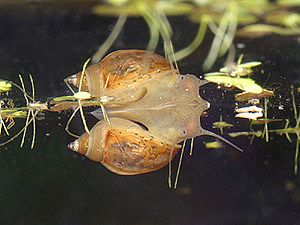 Bladder snail (Physidae family) floating on the water surface's underside. Picture: © Vollrath Wiese. |
Many other freshwater snails, though, do not breathe using gills. Their gills are reduced, instead leaving to the snail the thin wall of the mantle cavity to assimilate oxygen through. This organ is called a snail's lung, so this kind of snails is also referred to as pulmonate (lung breathing) snails (Pulmonata). Those lung-breathing snails make, by far, the largest part of known gastropod species. The advantage of breathing with lungs is obvious: Those snails can breathe oxygen from dry air and do not have to rely on water.
To be able to do this, freshwater snails breathing with lungs have to regularly go to the surface. They climb plants or simply float to the surface. Some freshwater snails can even crawl on the lower side of the water surface, eat algae while doing so and breathe oxygen from the air. This is possible because of the water's surface tension, which makes it possible for a water strider to run over the water surface.
Not only do pulmonate snails float at the water surface (apart from the Physidae in the left picture, it is for example also the Lymnaeidae and the Planorbidae), but also gill-breathing snails, such as the lesser mud snails (Hydrobiidae), among which the behaviour might rather serve the purpose of finding food than of breathing.
![]() More about
lesser mud snails and spring snails (Hydrobiidae).
More about
lesser mud snails and spring snails (Hydrobiidae).
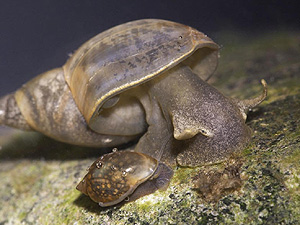 Great pond snail (Lymnea stagnalis) with bladder snail (Physella acuta). Picture: Lars Peters. |
Among those freshwater snails breathing with lungs, for example, are pond snails (Lymnaeidae). Actually, with up to 60 mm shell length the great pond snail (Lymnaea stagnalis L. 1758) is the largest land snail in Europe. In contrary to that are the largest European terrestrial snail, the Roman snail (Helix pomatia) with 50 mm shell height at most and the largest gastropod of all in Europe, a slug, is the ash-black slug (Limax cinereoniger) with a body length of more than 20 cm (8 in.). (!)
Pond snails have got an elongate shell that is often extended characteristically in the aperture area. They mainly live in calm waters such as ponds and backwaters, where they can graze plant matter and decaying organic matter (detritus). Compared to nerites, mud snails and Bithynias, pond snails lack a proboscis, as well as an operculum. But then again, none of the pulmonate snails have one.
On the other hand, both have something in common: Pond snails as well have only two tentacles, which they cannot withdraw. At the tentacles' base, there are two eyes, that can be seen in the picture on the left as black dots in front of each tentacle. A pond snail's triangular tentacle lobes are full of blood vessels, thanks to which the snail can breathe by tissue respiration under water. As a result, it does not need to surface as often. The respiratory hole is elongated to form a respiratory tube, serving the snail as a snorkel to get fresh air, without the need to surface.
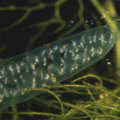 |
Pond snails are hermaphrodites, whose characteristic egg packets can be found on water plants (picture left) and rocks. Contrary to the Roman snail, which is also a hermaphrodite and whose copulation takes place mutually and simultaneously, pond snails act as male or as female at one time, but not simultaneously.
Among pond snail populations with a low number of individuals, for example, after a new pond has been populated, pond snails may even resort to auto-fertilisation to increase their number. To mix genes, of course, sexual fertilisation by mutual copulation is indispensable.
Pond snails have also served in an important genetic discovery: Using the example of the wandering pond snail (Radix labiata, at that time known as Lymnaea peregra), the American geneticist Alfred Henry Sturtevant (1891-1970) tried to understand how the coiling of snail shells is inherited. The dwarf pond snail (Galba truncatula) is an intermediate host to the liver fluke (Fasciola hepatica), whose infection can cause heavy liver dysfunction in the terminal host, such as a mammal, even a human.
![]() More about
pond snails (Lymnaeidae).
More about
pond snails (Lymnaeidae).
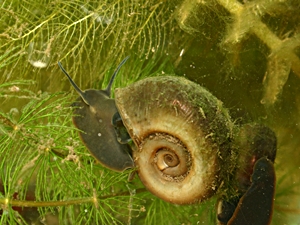 Ram's horn snail (Planorbarius corneus). Picture: © Alexander Mrkvicka, Vienna (mrkvicka.at). |
|
Movie: Ram's horn snail (Planorbarius corneus) in an aquarium. Source: YouTube. |
The name ram's horn snail is because of the shell's resemblance with a ram's coiled horn. The scientific name, though, Planorbis, is due to the shell form (plan-orbis: Latin for a flat disc). And literally, the spire of a ram's horn snail does not ascend, like in other snail shells, but remains plane, even receding into the shell's interior.
Among the family of ram's horn snails (Planorbidae GRAY 1840) there are also other ram's horn snails, but also the unusually formed river limpet (Ancylus fluviatilis, see below).
Most ram's horn snail species inhabit calm water rich in plants. They are also able to endure their home water falling dry for a certain period of time. Contrary to many other snail species, ram's horn snails have got red blood - their blood pigment, like in human blood, is haemoglobin. Aquarium keepers very much like specimens low in pigments, that look pink because of their blood shining through.
Looking at a ram's horn snail, one can see, that like a pond snail, it lacks an operculum at the foot tip. There are other snail species like the Colombian ram's horn snail (Marisa cornuarietis) that look like a ram's horn snail, but in fact, are not one. They have an operculum at their foot tip and besides are more closely related to mud snails and apple snails (Ampullariidae).
Like pond snails, neither does the ram's horn snail have a proboscis, but clearly visible lips. Alike the former, its tentacles cannot be withdrawn and are two in number, eyes placed at their base. Ram's horn snails, like pond snails, are hermaphrodites, deposing their flat, disc-shaped egg packets on plants and stones.
Some ram's horn snail species are also notorious for being intermediate hosts to dangerous parasites: The tropical ram's horn snail Biomphalaria glabrata, for example, is an intermediate host to the blood fluke (Schistosoma mansoni) which is the cause of a severe tropical disease called Schistosomiasis or better known as Bilharziosis.
![]() More about
ram's horn snails (Planorbidae).
More about
ram's horn snails (Planorbidae).
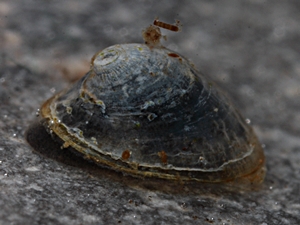 The river limpet (Ancylus fluviatilis) is not a limpet, despite looking like one, but more closely related to a ram's horn snail. Picture: © Alexander Mrkvicka, Vienna (mrkvicka.at). |
Despite looking externally like a limpet, the river limpet (Ancylus fluviatilis) is more closely related to ram's horn snails, with which it shares a common family. There are, in fact, several snail groups, in which a limpet-form shell has evolved. Another, for example, is the lake limpet (Acroloxus lacustris), which belongs to another family.
Albeit its name, the river limpet does not live exclusively in rivers, but in all types of waters with a high oxygen content, such as the littoral zone of lakes, is fast flowing sections of rivers, from the source creek into the wide river areas.
The river limpet also has earned importance as an indicator
fossil: 9,500 to 8,000 years ago, where today there is the Baltic Sea, there was
a freshwater lake. When the glaciers had molten, the land masses rose (isostasy)
and a land bridge between Denmark and Sweden isolated the Eastern Sea. By
precipitation and freshwater from its tributary rivers, the sea changed into
freshwater and a lake evolved, which for the most important indicator fossil,
Ancylus fluviatilis, today is known as Ancylus Lake
(![]() See Map).
See Map).
![]() More about Fresh Water Limpets.
More about Fresh Water Limpets.
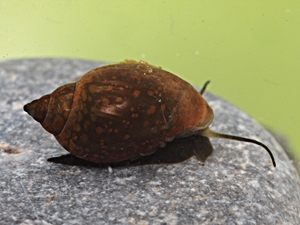 Acute bladder snail (Physella acuta). Picture: © Alexander Mrkvicka, Vienna (mrkvicka.at). |
Bladder Snails (Physidae) together with ram's horn snails (Planorbidae, s.o.) have in common their thread-like tentacles, other than, for example, the ear-shaped tentacles of a pond snail.
A bladder snail's shell only grows to about 10 mm in height - the difference in size to a comparatively giant pond snail (on top of the page) catches the eye. The last whorl of the shell is very much expanded, so it is larger than all of the remaining spire. The bladder snail, like the snails mentioned earlier, does not possess an operculum.
The acute bladder snail prefers warm standing waters and has been widely spread into the rest of Europe coming from the South-West.
![]() More about
bladder snails (Physidae).
More about
bladder snails (Physidae).
Compared to freshwater snails breathing with gills, there are clear and obvious differences in the snail species described on this page:
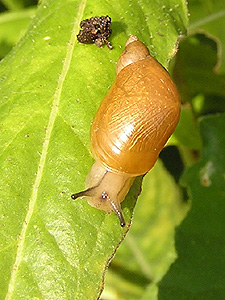 Amber snail (Succinea putris). [RN] |
Keeping in one's mind, that especially smaller water bodies on the continents bear the imminent danger of drying out, the advantage of water-living snails breathing with lungs is obvious: They can also breathe oxygen from the air and so can survive outside of the water, they might even cross some distance on dry land to reach another water body.
If they have to do so, there is also another advantage: Many freshwater snail species are able to auto-fertilise themselves to increase the number of individuals in their population (See for example: Pond snails).
As well, though, like all other water-living snails, pulmonate freshwater snails have only one pair of tentacles that are not retractable and at the base of which the eyes are placed. They are therefore called Basommatophora or base-eye snails. In contrary to that, there is another large group of snails, making the largest part of land snails, called Stylommatophora (literally the stalk-eye snails or terrestrial pulmonates). Those have eyes at the tip of a second, longer, pair of tentacles, all of which can be withdrawn. All those lung-breathing snails are grouped together as lung snails or pulmonates (Pulmonata).
This revolutionary breathing method, and the ability resulting from it to adapt to many more living places than gill-breathing snails, has led to pulmonate snails' species number by far prevailing all of the snails and finally all of the molluscs.
Among the stylommatophorans, for example, are amber snails (Succineidae). This snail family never lives far from the next pond, a fact that has led to the false assumption of them living amphibious. But amber snails only often live on plants near the water, but never in it. There they graze algae or other plant matter. Like pond snails, amber snails also may perform auto-fertilisation to increase their population's size in number.
Living in the nearest vicinity of water also bears many dangers for amber snails: Parasitic distomes (Trematoda), infecting a warm-blooded animal as terminal host, will pass a snail on their way in development. The snail eaten by a bird of mammal lead to the latter's infection with the distome's larvae.